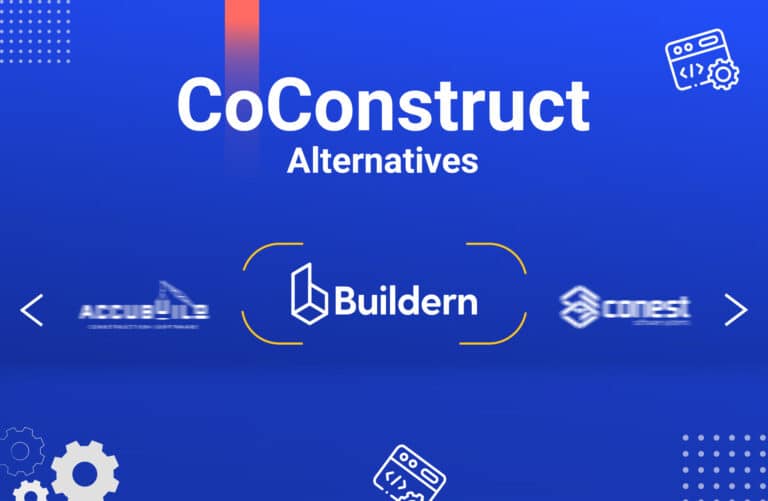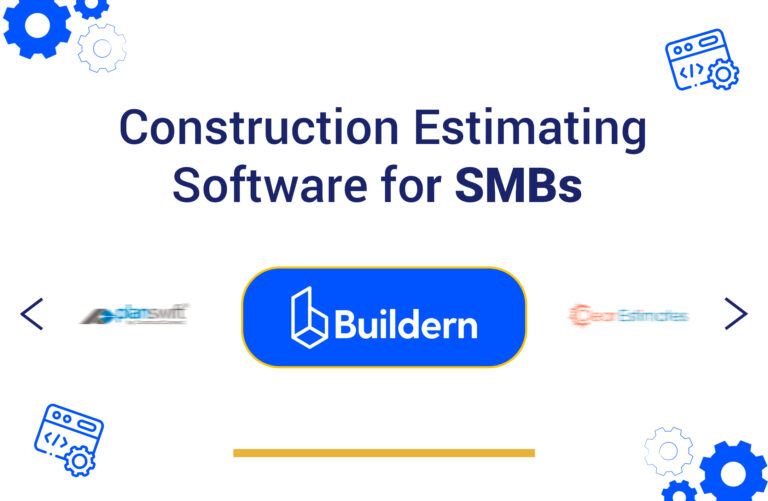9 Applications of QR Codes in Construction to Boost Efficiency
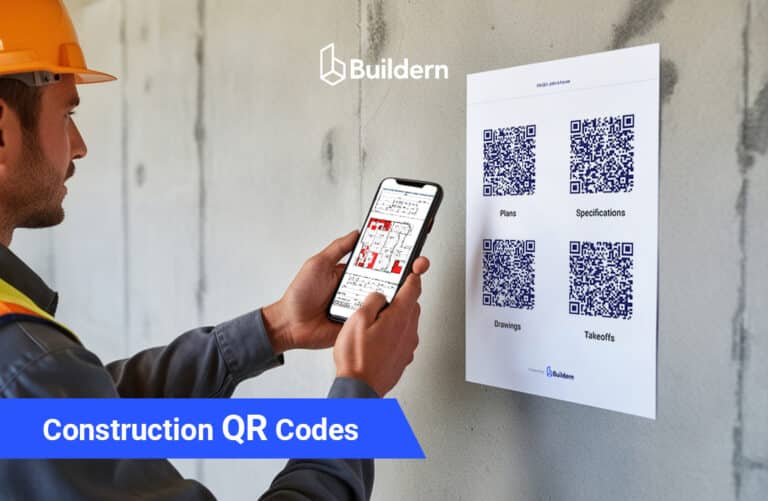
Have you ever found yourself juggling with stacks of paper plans on the construction site, only to discover an error or last-minute change that sends you back to the office for yet another printout?
If this sounds familiar, you’re not alone.
Builders everywhere face the ongoing challenge of managing hard copies on the jobsite, which can be both time-consuming and costly when updates are needed.
Luckily technology is revolutionizing every industry, and ours is no exception. QR codes in construction replace cumbersome paper plans with digital document management that can be accessed instantly and updated on the go.
Let’s further explore the 9 most innovative applications of construction QR codes that promise to save time, cut costs, and boost your team’s performance.

Table of Contents
What are QR Codes and How Do They Work?
In simple terms, QR codes, or Quick Response codes, are two-dimensional barcodes that store files, which can be accessed quickly by scanning them with your smartphone camera or a QR code reader.
Today, more and more builders choose to include QR codes on their paper plans, as well as throughout the construction site. You can share your construction blueprints, grant access to safety documents, track asset locations, and more by scanning these little black-and-white squares.
Do your construction sites need QR codes?
While the idea of integrating QR codes into your construction workflow sounds appealing in its simplicity and potential efficiency gains, you might be wondering if your construction sites truly need to adopt this technology.
Before the transition, you should realize the usefulness of a construction QR code depends on how you use the technology and your specific work needs.
With this in mind, here are some proven applications to free you from the loads of paperwork.
9 Construction QR Code Applications to Enhance the Team’s Efficiency and Safety
From file sharing to tracking updates and sharing training materials, construction QR codes have a dozen uses.
And most importantly, you don’t need specialized equipment for either case.
A standard smartphone or tablet equipped with a camera suffices to scan and access the information embedded in these codes.
1. Blueprints and Construction Plans
Takeoff plans are crucial when it comes to onsite construction. However, the large format of these plans can be a challenge to share and store.
What’s more, changes may occur through various stages, resulting in the distribution of new plans.
So, how do you manage the workflow in such cases?
We’ve done our professional research and found that some builders prefer using third-party QR-generating platforms to solve this issue. This can be a practical solution unless you are handling small projects with minimal paperwork.
However, most builders today prefer to keep all their construction data stored and managed in one location. Thus, they seek comprehensive software solutions that not only align with their business needs but also facilitate the use of QR codes.
That’s exactly how Buildern tackles this issue!
It’s a unified platform, allowing users to organize your construction document management. With Buildern, you can effectively generate QR codes for all your files and folders.
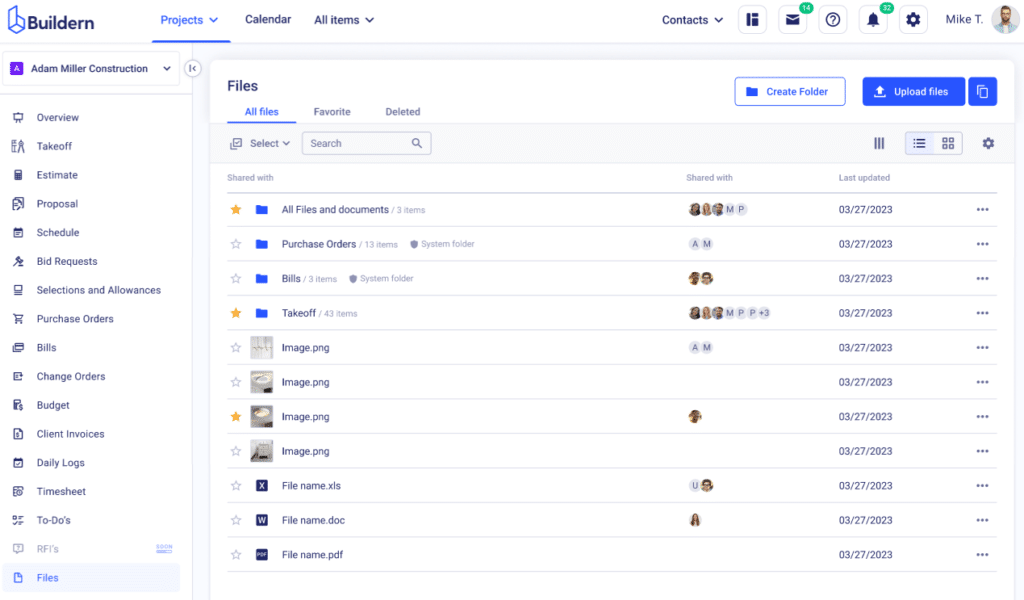
Supporting nearly all file types from PDFs to ZIP files, this means you can easily scan and view any document or plan on your mobile device.
💡Recommended Reading
How to Generate QR codes for the Files and Folders?
Automatic Updates with QR Codes
One of the key benefits of using QR codes with Buildern is the automatic updating feature. Whenever you add new files or update existing ones in the system, the QR code will automatically reflect these changes.
This means that anyone scanning the QR code will always have access to the most current version of the document without needing a new code. Working with Buildern eliminates confusion and ensures all team members stay aligned with the latest project information, enhancing communication and efficiency on construction sites.
2. Training and Onboarding
The use of QR codes in construction can significantly streamline the employee training and onboarding process by providing quick access to essential video files and literature.
First, you should have useful onboarding videos and worker training records. Compile all your employee onboarding sources in your file library.
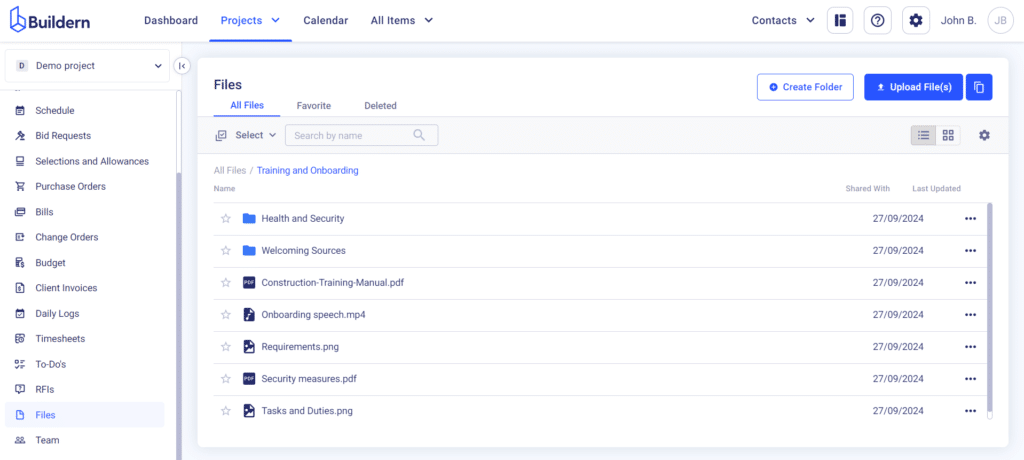
Next is generating free QR codes for all the necessary files, printing and distributing them across the work site.
Buildern allows you to download each QR code in a separate PDF file. But you can also generate QRs in bulk and have them uploaded all together in a single PDF. The best part of using Buildern is that you don’t have to keep track of which QR codes correspond to which files. Each QR will have the corresponding file’s name written under it.
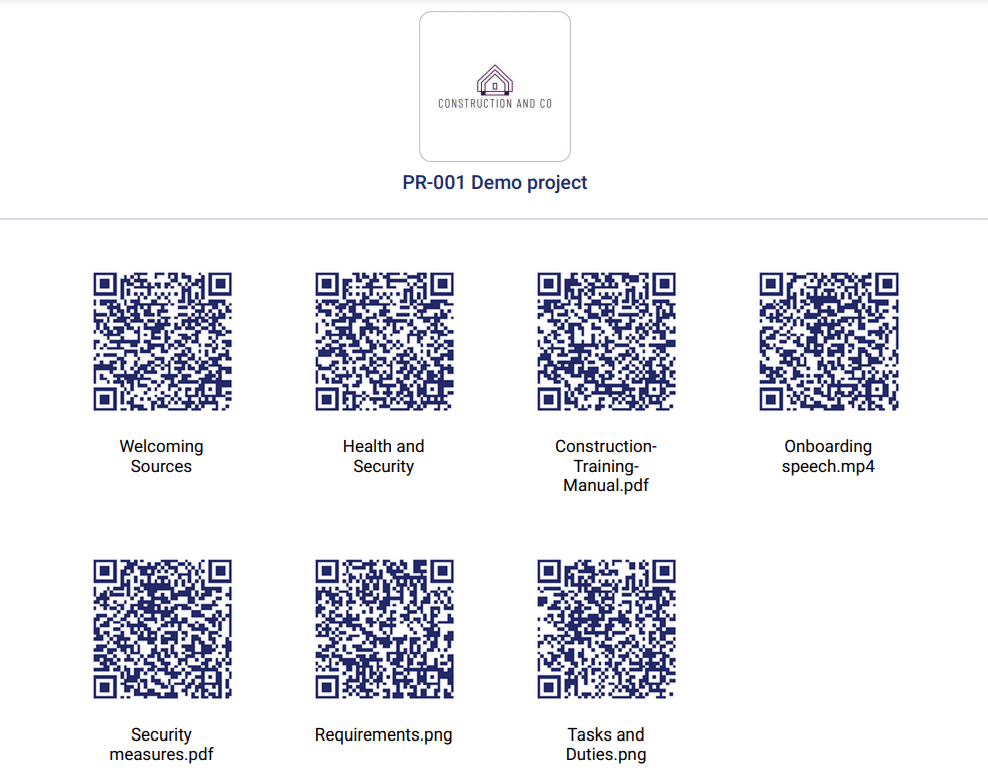
Protecting sensitive information is crucial during the training and onboarding process, and Buildern allows you to enhance security by creating PIN-protected QR codes.
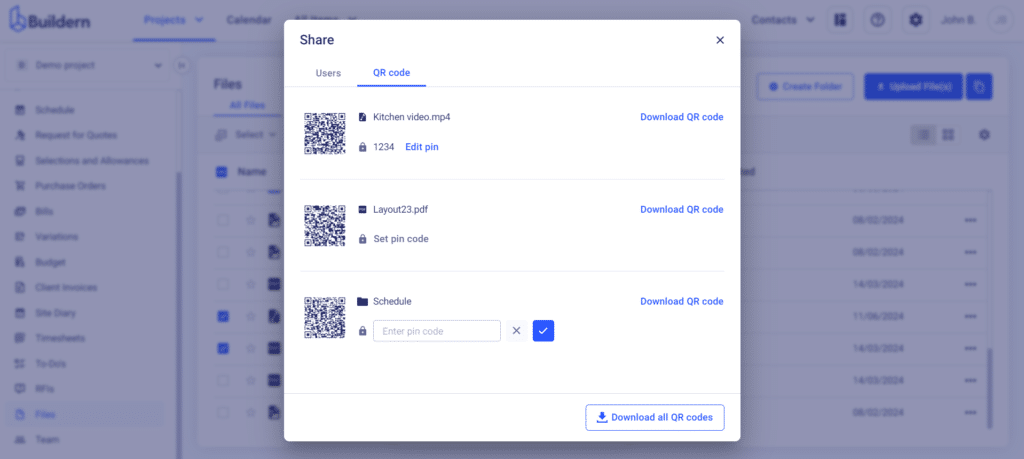
The functionality ensures that only authorized personnel can access critical files and documents, providing an added layer of security for your company’s data. By simply setting a secure PIN when generating these QR codes, you can rest easy knowing that your information is shielded from unauthorized access.
3. Tool and Equipment Management
Thefts at construction sites can cost the industry from $300 million to $1 billion annually.
This substantial financial loss highlights the need for improved management and security systems to protect your assets. Of course, hiring a team that you trust is crucial. However, another way to address this challenge is by implementing a system for tracking and documenting equipment usage.
Modern technologies like construction QR code software can help you create digital records for material and equipment tracking to have everything accounted for.
The first thing is linking QRs to a database that records relevant information. Each piece of equipment should be assigned a unique QR code, which can be scanned using your mobile device or a scanner. When the code is scanned, it accesses the database to display the current status, usage history, and authorization details of the equipment.
This will help you implement regular audits and maintain a comprehensive equipment checklist to track usage and prevent unauthorized access.
Next time when someone tries using or taking a piece of equipment without proper authorization, you can simply scan the QR code to check if it’s been used and by whom.
4. Safety and Compliance Verification
Another application of QR codes in construction suggests containing instructions and specific guidelines on how to use the equipment safely. You can embed safety protocols and operations instructions directly into the QRs. This way your workers can easily access detailed information on proper handling and safety measures.
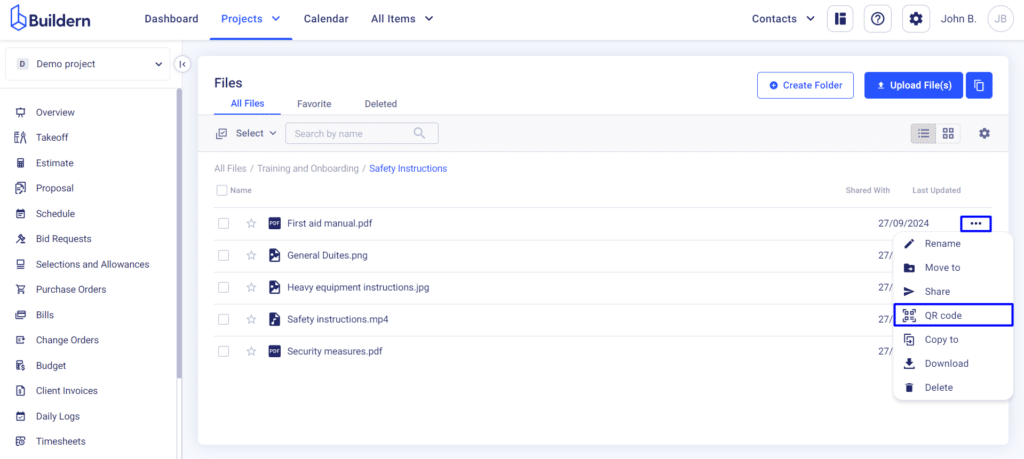
The use of QRs in this case not only helps in preventing accidents but also serves as an on-the-spot training tool for employees who may be unfamiliar with certain equipment.
5. Client and Stakeholder Updates
QR codes in construction can significantly enhance communication with clients and stakeholders in the construction industry by providing real-time updates on project progress.
You can integrate QR codes in your invoices or print them for display on construction site signs. Clients and stakeholders can then scan the codes to access project updates, photos, and videos.
This can be especially handy when you want to show the future appearance of a project to build trust and transparency. Additionally, it can facilitate prompt decision-making and reduce delays in project completion.
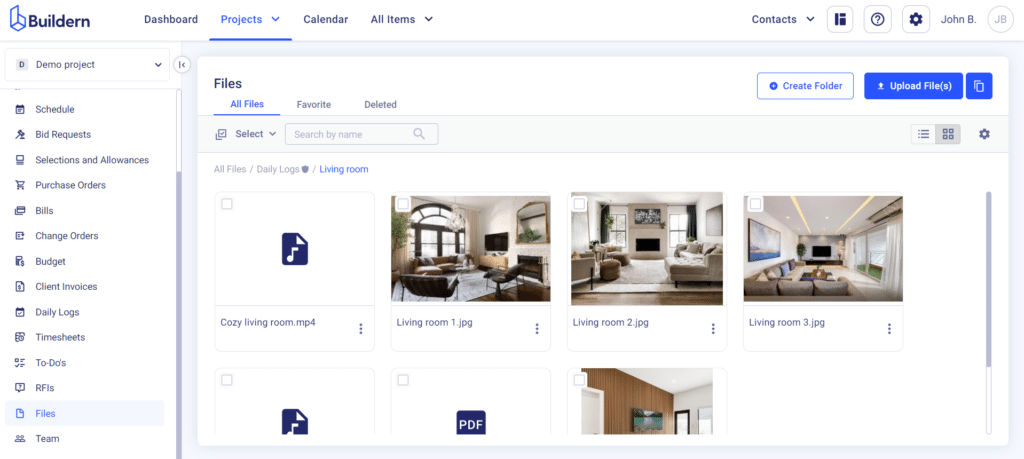
6. Inspections and Quality Control
How do you implement quality control on your jobsite? QR codes offer innovative solutions to ensure your work meets on-site requirements.
First, builders can attach QR codes to specific areas of the construction site, linking directly to detailed inspection checklists. This ensures that inspectors have real-time access to complete and accurate documentation, reducing the probability of overlooked steps.
Secondly, construction QR codes can facilitate tracking of completed inspections by connection to the central database. Anyone scanning the barcodes can easily access the records of all the previous inspections making it straightforward to review past assessments and confirm that any identified issues have been resolved.
And last, by not least, QR codes can be used to document and verify that materials and equipment meet quality standards. By scanning the QR code, inspectors can instantly access certificates of compliance and manufacturer specifications, ensuring that everything used on-site adheres to the required regulations.
7. Waste Management
Try attaching QR codes to waste bins and dumpsters on the jobsite and linking them to information on proper disposal methods for certain materials. Barcodes here help with waste segregation and allow your project managers to track and analyze waste output efficiently.
Moreover, to encourage and track waste reduction efforts, project teams can employ QR codes that connect to incentive schemes, rewarding teams that achieve set waste management targets. This is an ideal example of using QRs for sustainability and promoting a more environmentally friendly approach to construction.
8. Emergency Management and Response
You can place medical QR codes around your construction site or on personal safety equipment like hard hats. Such codes should hold vital information such as emergency contact numbers, medical histories, and instructions on how to respond to various medical emergencies. When scanned, these QR codes provide immediate access to this information, which is crucial during time-sensitive situations.
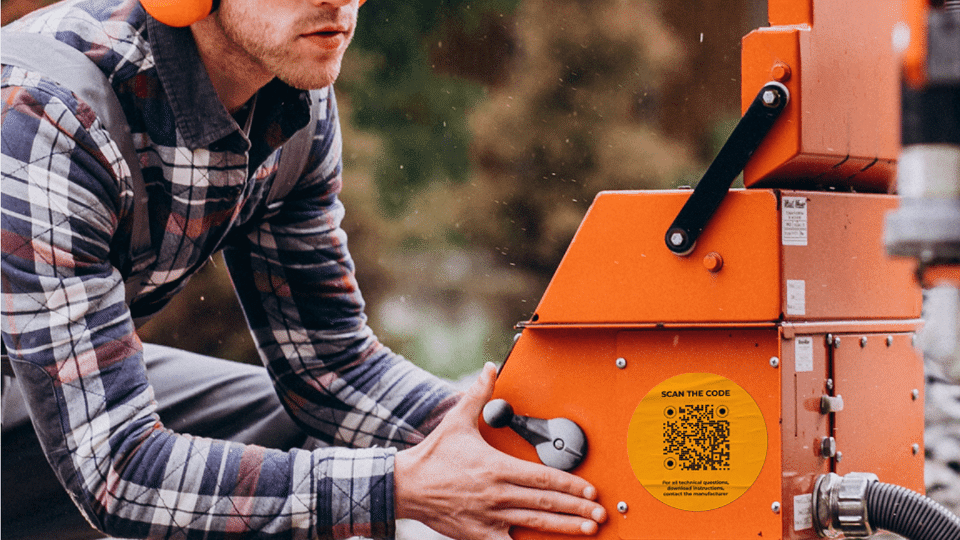
QR codes for construction sites can also streamline the emergency first response by linking to procedural guides and checklists for specific scenarios like fire outbreaks or structural collapses. By doing so, they ensure that all personnel on-site have instant access to the best practices and protocols needed to handle emergencies efficiently.
9. Billing
Generating QR codes for bill sharing is another useful case especially when you may need to share expenses with your stakeholders, suppliers, or other team members. Project managers can use the codes to share invoices and payment receipts electronically, ensuring secure and timely transactions.
For instance, a sustainable use case is generating a QR code for related bills and placing it on relevant documents. This approach eliminates the need for project managers to print and attach multiple documents, streamlining the process and reducing paper waste effectively.
Conclusion
With so many potential uses, QR codes have the power to transform the construction industry by increasing efficiency and promoting safety.
Just imagine!
All you need to do is download, print, and place the QR codes around your work site. When someone needs access to a specific file or document, all they have to do is scan the QR code with their mobile device.
It’s as easy as that.
What’s more, Buildern’s commitment to innovative solutions ensures your construction projects run smoothly and securely, making on-site management a reality.


